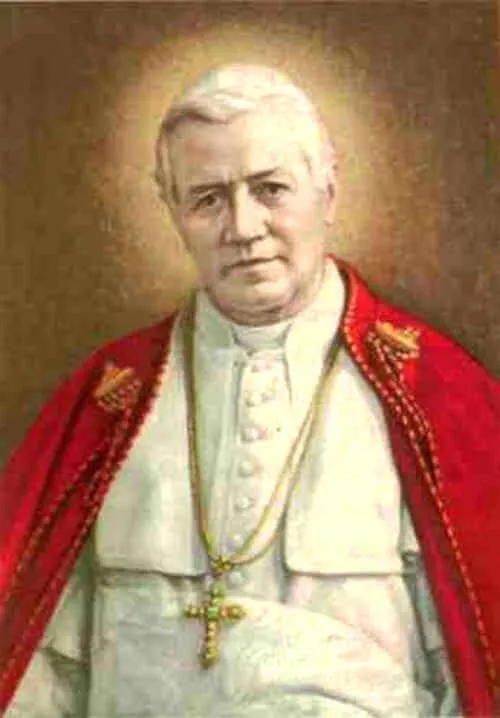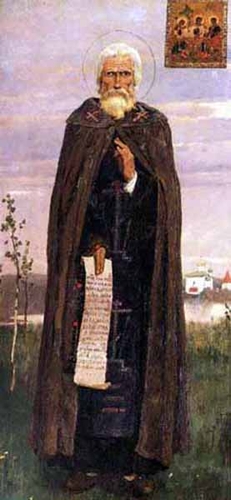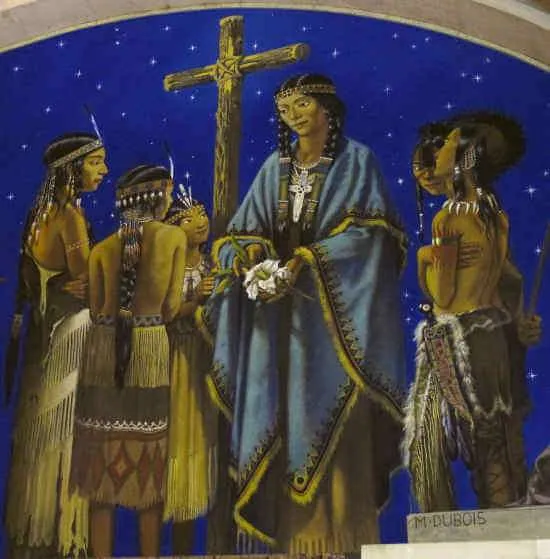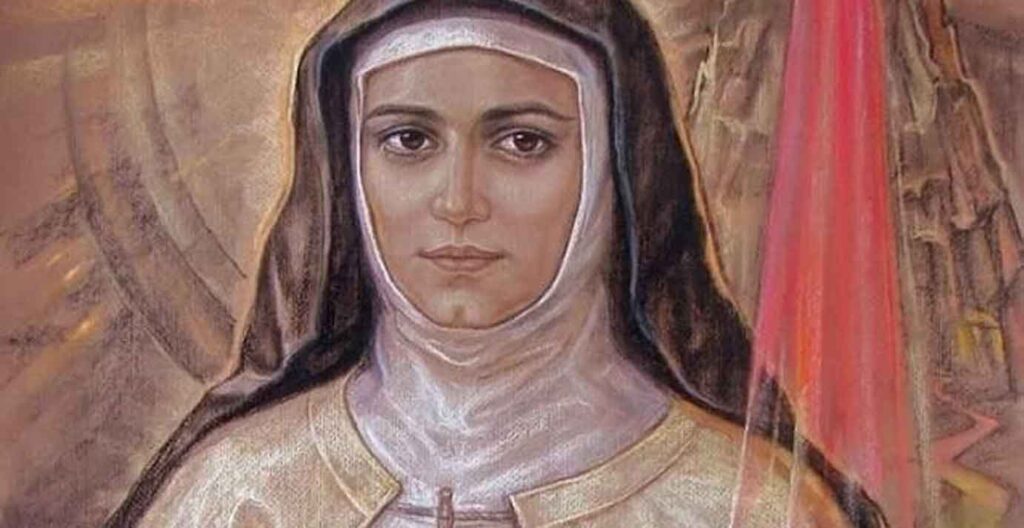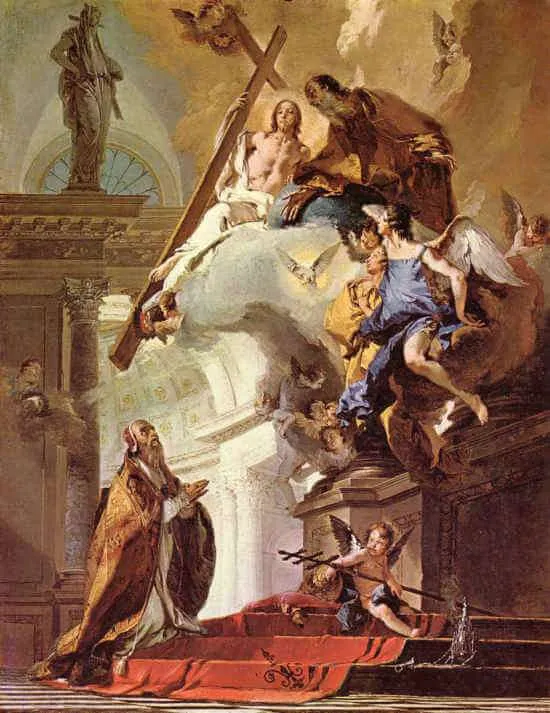1835–1914; Patron Saint of First Communicants and pilgrims; Canonized by Pope Pius XII on May 29, 1954
Giuseppe Melchiorre Sarto was born in Riese, Kingdom of Lombardy-Venetia, present-day Italy. He was born into a poor family, the second of ten children. His father was a postman and his mother a seamstress. His family was very devout and Giuseppe learned the Catholic faith by both word and example. As a child, he was educated at home and by the local parish priest, Father Tito Fusaroni, who was very impressed by Giuseppe’s piety and intelligence. As a result, when Giuseppe was old enough, Father Fusaroni paid for his education at the gymnasium of Castelfranco Veneto, just a few miles from his home to which he walked each day. Because he was poor, he was often teased by the other students, but this only built his character. The gymnasium, as it was called, was a school geared toward academic excellence with the intent of preparing students for further studies. Around the age of fifteen, Father Fusaroni secured a scholarship for Giuseppe, who was sent to the Seminary of Padua, just over twenty miles south of his home, where he studied the classics, philosophy, and theology. He advanced to the top of his class but remained prayerful, generous, kind, and humble, while manifesting an unwavering faith throughout. Upon completing his studies, he was ordained a priest on September 18, 1858 at the age of twenty-three.
After ordination, Father Sarto became an assistant priest at the parish in Tombolo where he spent the next eight years. The pastor, Father Constantini, was older and often sick, which meant that Father Sarto quickly became the de facto pastor, fulfilling most of the priestly duties. He had a great respect for his pastor and often sought his advice. Father Constantini, in turn, grew in admiration for Father Sarto. He later said of him, “He is so zealous, so full of good sense, and other precious gifts that it is I who can learn much from him. Some day or other he will wear the mitre, of that I am sure. After that—who knows?” In Tombolo, Father Sarto was especially attentive to the needs of the poor, being raised poor himself, taught adult education classes, trained the parish choir in Gregorian Chant, carefully prepared his homilies, sought advice, and had a genuine concern for the good of his parishioners. In his spare time, he continued his studies on his own, studying the theology of Saint Thomas Aquinas as well as canon law.
In 1867, because of his excellent work in Tombolo, Father Sarto was appointed archpriest of Salzano. As archpriest, he had administrative and pastoral responsibilities over the entire territory with the assistance of priests under him. He continued the pastoral practices he had become accustomed to, as well as restoring the dilapidated church, expanding the Catholic hospital, and caring for the sick during an outbreak of cholera.
At the age of forty, Father Sarto was elevated to the prestigious responsibilities of Canon of the Cathedral at Treviso, Chancellor, and Vicar General. He also became the Spiritual Director of the diocesan seminary where he became deeply devoted to the formation of new priests. These important responsibilities, however, could not take him away from common people. He remained faithful to teaching catechism to children and adults and always reached out to the poor and needy.
In 1884, Pope Leo XIII named Canon Sarto as Bishop of Mantua, in north-central Italy. Though he at first resisted, the pope insisted. At that time, the Diocese of Mantua was in disarray. Just fourteen years prior, the Church had lost its temporal power over the Papal States, due to the establishment of the Kingdom of Italy. The Church and state were often at odds. The Church lost much of its influence, property, and internal control in those territories, including in Mantua. As a result, Bishop Sarto found a general indifference and secularism that was rampant. Bishop Sarto went to work. He invigorated the education of the laity, personally devoted himself to teaching in the seminary, reintroduced the scholastic theology of Saint Thomas Aquinas and Gregorian Chant, and breathed new life into his seminarians, presbyterate, and diocese. Because of his good work, in 1893, Pope Leo XIII, appointed Bishop Sarto as Patriarch of Venice and named him a cardinal.
In Venice, Cardinal Sarto continued to do what he had always done. He devoted himself to the seminary, where he mandated the teachings of Saint Thomas Aquinas, the use of Gregorian Chant, and introduced a faculty of canon law. He continued to catechize young and old, engaged in social works, avoided politics, and never lost his affection for the poor, ministering to them every chance he could. In 1903, after Cardinal Sarto spent nine years in Venice, Pope Leo XIII died and the cardinals gathered to choose his successor. The election of a pope at that time was governed by rules established in 1588 by Pope Sixtus V. Those rules permitted outside influence, such as vetoes, exercised by some civil authorities. In the conclave of 1903, the Emperor of Austria vetoed Cardinal Mariano Rampolla del Tindaro, the Secretary of State under Pope Leo XIII, who was the first to be elected. This veto was delivered through the Prince-Bishop of Krakow. A few ballots later, Cardinal Sarto received almost unanimous consent and was elected pope at the age of sixty-eight years, choosing the name Pius X. He later changed the rules for papal elections, eliminating outside influence such as the veto.
As pope, Pius X took as his motto, “To restore all things in Christ” (Ephesians 1:10). Remaining as he was when he was a parish priest, spiritual director, and bishop, he was humble, simple, loved teaching children, and showed concern for the poor. He introduced a universal catechism, reformed the curia, renewed seminary formation, revised the Code of Canon Law, revitalized the liturgy, encouraged Gregorian Chant, and emphasized the teachings of Saint Thomas Aquinas. At heart, he was a pastor, not a diplomat or politician. Without ambition, he never sought the elevations he received, but accepted all things in Christ with humility and surrender.
Most notably, his love for children and his long history of catechizing them led him to lower the age for First Holy Communion from twelve to seven, encouraging frequent reception of the Eucharist for them and all people. Deeply devoted to the Blessed Virgin Mary, he often spoke of her and honored her. Although he never received a doctorate degree, he was highly intelligent and firmly opposed modernism within the Catholic Church, viewing it as a synthesis of all heresies where doctrines were presented in a scattered and disjointed manner, thus creating doubts. In response, he preached that the Catholic faith was very reasonable, systematic, and clear—hence, his love for Saint Thomas Aquinas and Canon Law.
After Pius X’s death, he became the first pope to be canonized since Pope Saint Pius V, who died in 1572. His death came just weeks after the start of World War I. As he watched the growing tensions throughout the world, his pastoral heart was deeply distressed, and the sorrow he saw unfolding before him might have contributed to his death.
As we honor the first saintly pope of the last century, ponder his slow rise from an assistant priest to pastor of the world. This was done by God’s hand. All Pope Saint Pius X did was love, teach, care for the poor, pray, and be faithful to the teachings of Christ. God did the rest. For our part, our duty is to do every small thing well, loving God and others at every moment of our lives. If we do that well, repeatedly, God will be able to use us in unimaginable ways.
Source: https://mycatholic.life/saints/saints-of-the-liturgical-year/august-21—saint-pius-x-pope/


